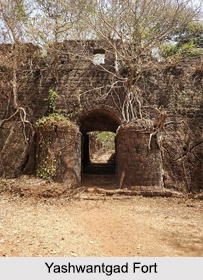 Yashwantgad Fort is located in Redi, Maharashtra, near the Maharashtra-Goa border. Also known as Redi Fort, it is located on a small hill North of Jaitapur creek. It is a tree-entangled ruin that looks out over the beaches of the south Maharashtra coast. The fort was then of a great prominence to Marathas due to its tactical and strategic positioning which also served as a major trading point. Yashwantgad Fort is now a "Protected Monument" under the Maharashtra Ancient Monuments and Archaeological Sites and Remains Act, 1960.
Yashwantgad Fort is located in Redi, Maharashtra, near the Maharashtra-Goa border. Also known as Redi Fort, it is located on a small hill North of Jaitapur creek. It is a tree-entangled ruin that looks out over the beaches of the south Maharashtra coast. The fort was then of a great prominence to Marathas due to its tactical and strategic positioning which also served as a major trading point. Yashwantgad Fort is now a "Protected Monument" under the Maharashtra Ancient Monuments and Archaeological Sites and Remains Act, 1960.
History of Yashwantgad Fort
Yashwantgad Fort was built by the Marathas between 1707 and 1713 as a part of Admiral Kanhoji Angre"s line of fort defences built for Maratha Queen Tarabai Bhosale. It was later captured by the Portuguese in 1746. The previous citadel holders, the Sawant clan of Maharashtra, were desperate to regain the fort because of its valuable strategic position on the coast. An attempt to recapture Redi fort was preceded by poisoning the Portuguese garrison"s fish supply, but the attack was unsuccessful. The fort was eventually returned to the Sawants following a peace treaty, but the success was short lived. In 1765 the fort was captured by the British who later sold the land to local people in 1890 while retaining ownership of the fort walls.
Structure of Yashwantgad Fort
The area of the fort is 3 hectares. The Fort is built on two levels – the Lower Fort, which is the larger one with its base touching the creek and a fresh water well inside, and the Upper Fort, which is smaller and on a hillock to keep watch on maritime activities in the surrounding waters. There is a 20 feet deep dry moat around the fort. There are four gates to be passed to enter the fort. The entrance gates and the guard vestibules are in good condition.
Visiting Information of Yashwantgad Fort
Yashwantgad Fort is located 33 km from Sawantwadi and 26 km from Vengurla. The fort can be accessed by two routes; Ratnagiri–Pawas–Adivare–Nate and Rajapur–Nate. State Transport buses are available from Rajapur and Ratnagiri to reach Nate. It takes 15 minutes on foot to reach the fort from the village or one can also opt for an auto till the base. Buses going to Ambolgad can be taken to plight at the fort.



















